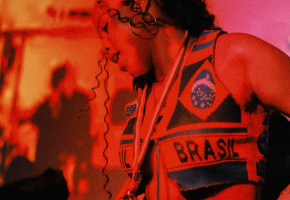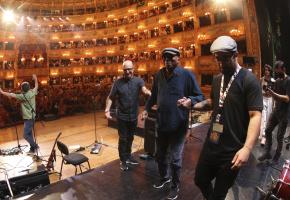Imagine being in Rio in the early ‘60s, a bar on the beach, the long hair and swaying hips of passing girls inspiring melodies such as The Girl from Ipanema, and the great US Jazz musicians routinely appearing to hear first hand the amazing sound of a new music called Bossa Nova, whose songs later became standard Jazz repetoire. This is the stuff that legends are made of, the stuff of music.
The original creators of this movement, the likes of Tom Jobim, João Gilberto and Vinicius de Morais, became immortalised in the minds of music lovers all over the world, for the . But out of all of these legendary artists who put Brazilian music on the global map, Sergio Mendes was the most successful. A pianist, songwriter, arranger and bandleader, he enjoyed a lengthy career that began in the bossa nova boom of the early 1960s and continued for six decades – long after the bossa craze was over.
Sergio may not have been the most talented or innovative of those musicians: is success was based on his skill in matching Brazilian songs and rhythms against different western styles, from jazz and rock to funk and hip hop. Based out of Lose Angeles, some say he was the man who put the funk into bossa nova, others say he was Brazil’s Perez Prado - bringing bossa nova to the world, where Prado brought Mambo - but essentially Sergio Mendes took Brazilian hits and made them global mega hits.
Sergio Mendes leapt to international fame in 1966 and brought Brazilian music to the world stage with the “Brasil 66” LP, produced by Herb Alpert. Its hit single, a rendition of Jorge Ben’s Mais Que Nada was the first time that a song, sung entirely in Portuguese, reached the top five on the Billboard magazine pop chart. Did Jorge Ben mind people associating that song with and not him? Certainly not, Sergio once told LatinoLife. "All composers like their songs being made a success!” Mendes always credited his Brazilian peers, using his success to promote their music.
Sergio was in the right place, the right time and had the right charm. Enchanting the American music world, in 1971 he played at the White House for President Richard Nixon; and in 1982 was back to play for Ronald Reagan. In the 90s he became a hero for the easy-listening market, and in 2006, fourty years after the original hit, Sergio topped the charts and music channels with the same song, co-producing a Black Eyed Peas remix of that song.
Between then and now, Mendes toured internationally with Frank Sinatra, produced several gold and platinum records and many hit songs, won several Grammys and an Oscar nomination (for the animated film ‘Rio’), and made records with Stevie Wonder, Jill Scott, India Arie, Justin Timberlake, John Legend, Q-Tip, Erikah Badu among many others. To use a cliché, Mendes is a living legend.
With his stellar lined CV and commercial success, many forget that Sergio was and always remained essentially a Jazz man, who lived through very special musical times. When the American jazz stars Charlie Byrd and Herbie Mann visited Rio in 1961 to check out this new music, Mendes was one of those with whom they played. And when Brazil’s bossa heroes were invited to Carnegie Hall, New York, in November 1962 to collaborate with Byrd and other American jazz musicians, Mendes was included.
The visit transformed his career. While in New York, he met Cannonball Adderley, who invited Mendes to record with him, and he also met Nesuhi Ertegun, the president of Atlantic Records, who signed him up. But, the Brazilian's fate was arguably sealed when, in 1964, Mendes decided to move to Los Angeles. After two unsuccessful albums, he met the trumpeter Herb Alpert and Jerry Moss, the founders of A&M records, and signed to their label.
With them he hit on the formula that would make him a superstar. With what was to become his “trademark sound” of two girls singing together in the band, Brasil ’66 (1966) included Brazilian-influenced covers of western pop songs including the Beatles’ Day Tripper, with lyrics in English, but it was the reworking of the Jorge Ben classic Mas Que Nada, that helped the album reach the US Top Ten, and Mas Que Nada the first song in Portuguese to reach No 5 in the singles charts.
He notched up a further string of hits with Brazilian-influenced covers, including the Beatles’ Fool on the Hill, Simon and Garfunkel’s Scarborough Fair and Dusty Springfield’s The Look of Love and Going Out of My Head (originally recorded by Little Anthony and the Imperials). In 1967 he toured for the first time with Frank Sinatra, and in 1968 played his first concerts in Japan, where he became extremely popular, returning over 30 times.
His career dipped in the 70s, but he kept touring and recording – he would release more than 40 albums during his career. In 1980 Sinatra invited him for a second major tour, which included a show at the Royal Albert Hall in London, and three years later he notched up another hit with Never Gonna Let You Go. In 1992 he was awarded a World Music Grammy for his album Brasileiro,
After Black Eyed Peas’ hip-hop treatment of Mas Que Nada, reached No 1 in Hungary and the Netherlands and No 2 in the UK Hip Hop/R&B charts, Mendes played a show at the Barbican in London, at which he switched from his 60s hits to breezy easy listening, and he ended by performing the hip hop version of Mas Que Nada twice. His wife, Gracinha Leporace, was one of the two female singers.
In 2012 Sergio was nominated for an Oscar for his song Real in Rio from the animated film Rio, and in 2014 he again acted as producer, composer, arranger and performer for the follow-up, Rio 2. In 2015 he played to more than 100,000 fans at Rock In Rio, and in 2020 released the album In the Key of Joy.
A 2021 documentary about his life, Sergio Mendes: In the Key of Joy, included contributions from Alpert, Harrison Ford, Pelé and will.i.am. Mendes last performed in November last year, when his European tour included a return to the Barbican.



















